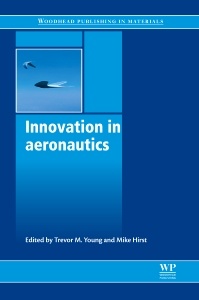Innovation in Aeronautics

Contributor contact details
Part I: Concepts
Chapter 1: Introduction to innovation in aeronautics
1.1 Introduction
1.2 Concepts
1.3 Change
1.4 Challenges
Chapter 2: Biologically inspired technologies for aeronautics
Abstract:
2.1 Introduction
2.2 Biologically inspired or independent human innovation
2.3 Nature as a source of innovation in aerospace
2.4 Biologically inspired mechanisms and systems
2.5 Robotics as beneficiary of biomimetic technologies
2.6 Conclusion: challenges and potential development
2.7 Acknowledgement
Chapter 3: Aircraft morphing technologies
Abstract:
3.1 Introduction
3.2 Early aircraft morphing developments
3.3 Keeping morphing alive – NASA research in morphing aircraft structures
3.4 Resurgence of morphing concepts
3.5 Current morphing component technologies
3.6 Conclusion: the future of aircraft morphing technologies
Chapter 4: Jet engine design drivers: past, present and future
Abstract:
4.1 Introduction
4.2 Technological drivers
4.3 New challenges
4.4 Meeting the challenges through innovation
4.5 Conclusion
Chapter 5: Innovation in avionic systems: developments underpinned by digital technologies
Abstract:
5.1 Introduction
5.2 Cost
5.3 Capability
5.4 Demand
5.5 Timing
5.6 Future requirements
5.7 Current safety processes
5.8 The system of the future
5.9 The ultimate avionics computer
5.10 System–crew interaction
5.11 Conclusions
Chapter 6: The environment as the key design driver in aeronautics
Abstract:
6.1 Introduction
6.2 Economic efficiency
6.3 Environmental impact
6.4 The characteristics of the aeroplane
6.5 What determines the value of the energy liberated to revenue work ratio (ETRW)?
6.6 Observations on the ETRW
6.7 Aircraft performance
6.8 Where does it all go? Explaining the discrepancy between energy liberated and revenue work
6.9 Improving the discrepancy between energy liberated and revenue work
6.10 Addressing the climate issue
6.11 Conclusions
6.12 Acknowledgements
Chapter 7: The human factors that relate to technological developments in aviation
Abstract:
7.1 Introduction to human factors as a discipline
7.2 Human factors in a socio-technical system context
7.3 A history of human factors
7.4 Recent developments and current trends
7.5 Future trends
7.6 Conclusion
Chapter 8: Innovation in supersonic passenger air travel
Abstract:
8.1 Introduction
8.2 Historical background
8.3 Operational issues
8.4 Technological issues: sonic boom
8.5 Technological issues: aerodynamics
8.6 Technological issues: airworthiness
8.7 Manufacturers and design organisations
8.8 Conclusion
8.9 Acknowledgement
Part II: Change
Chapter 9: The process of innovation in aeronautics
Abstract:
9.1 Introduction
9.2 Definitions and sources of confusion
9.3 How to measure innovation
9.4 The innovation process
9.5 Innovation environments
9.6 Innovation viewed as a management of knowledge problem
9.7 Whole systems view of innovation
9.8 Conclusion: innovation processes of the future
Chapter 10: Managing innovative technology development in aeronautics: technology assessment (TA) techniques
Abstract:
10.1 Introduction
10.2 Methods and limitations
10.3 Approach and example
10.4 Conclusion
10.5 Abbreviations
Chapter 11: Mining the ‘far side’ of technology to develop revolutionary aircraft prototypes: the Defense Advanced Research Projects Agency (DARPA) approach
Abstract:
11.1 Introduction
11.2 Defense Advanced Research Projects Agency’s (DARPA) philosophy and structure
11.3 DARPA and innovation in aviation
11.4 Examples of DARPA innovation in aviation
11.5 DARPA’s aviation-related programs
11.6 Conclusions
Chapter 12: Revolutionary ideas about the future of air transport
Abstract:
12.1 The mind set to find revolutionary solutions
12.2 Technological change
12.3 A framework for assessing revolutionary ideas
12.4 Carrying forward requirements into design
12.5 Telecommunications and IT in society
12.6 The revolution – far beyond the air vehicle
Part III: Challenges
Chapter 13: Intellectual property, patents and innovation in aeronautics
Abstract:
13.1 Introduction
13.2 Commentary on likely future trends
13.3 Creativity and innovation as a mechanism for capturing intellectual property
13.4 Intellectual property and patenting
13.5 Converting patents into products
13.6 Establishing patent value
13.7 Trends driving innovation within the commercial aerospace industry
13.8 The switch from aluminum to composites
13.9 Conception of AMP equipment
13.10 AMP equipment definitions
13.11 Evolution of AMP equipment
13.12 AMP equipment family tree
13.13 Conclusion
13.14 Sources of further information
13.16 Appendix: AMP acronym list
Chapter 14: Cost, time and technical performance risk mitigation in large, complex and innovative aeronautics development projects
Abstract:
14.1 Introduction
14.2 Interdependence of development cost, schedule, and technical performance
14.3 The aspect of risk
14.4 An integrated decision-support model – the risk value method (RVM)
14.5 Example: an unmanned combat aerial vehicle (UCAV) development project
14.6 Discussion
14.7 Conclusion and future trends
14.8 Sources of further information and advice
Chapter 15: Innovation in aeronautics through Lean Engineering
Abstract:
15.1 Introduction
15.2 Dynamics of innovation
15.3 Lean Thinking
15.4 Lean Thinking and aerospace
15.5 Lean Engineering framework
15.6 Tailoring Lean Engineering
15.7 Lean Engineering challenges
15.8 Summary
15.9 Acknowledgments
Part IV: Conclusion
Chapter 16: Conclusion: innovations in aeronautics
Abstract:
16.1 Introduction
16.2 Innovation and risk
16.3 Technology readiness levels (TRLs)
16.4 Capturing innovation and disruptive technologies
16.5 Key design drivers
16.6 Moving from concept to implementation
16.7 Computer-assisted engineering and design
16.8 The innovation process
16.9 Developing a culture of innovation
16.10 Innovation ‘agendas’
16.11 Education and innovation
Glossary
Index
Mike Hirst is a Senior Associate with Airport Planning and Development Ltd, Leeds, UK. He is a chartered engineer and aviation systems specialist with some 40 years’ experience in civil aviation, including flight testing, air traffic control and systems, airport design, and operations training, education and research.
- Explores a range of innovative aerospace design ideas
- Discusses how the process of innovation itself can be effectively managed
- Reviews developments including biologically-inspired technologies, morphing aerodynamic concepts, jet engine design drivers and developments underpinned by digital technologies
Date de parution : 06-2012
Ouvrage de 416 p.
15.5x23.2 cm



